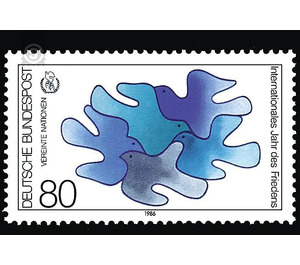International Year of Peace - Germany / Federal Republic of Germany 1986 - 80 Pfennig
Theme: History & Politics
| Country | Germany / Federal Republic of Germany |
| Issue Date | 1986 |
| Face Value | 80.00 |
| Color | white blue |
| Perforation | K 14 |
| Printing Type | 4-color offset printing |
| Stamp Type | Postage stamp |
| Item Type | Stamp |
| Chronological Issue Number | 1159 |
| Chronological Chapter | GER-BRD |
| SID | 95056 |
| In 36 Wishlists | |
On October 24, 1985, the 40th anniversary of the founding of the United Nations, the 40th General Assembly solemnly proclaimed 1986 the Year of Peace. The joint efforts of countries to promote international peace and security on the basis of the United Nations Charter should be strengthened and extended with the International Year of Peace. Forty years after the founding of the United Nations, the Charter's main goal of "saving future generations from the scourge of war" has not been achieved to date. There have been numerous warlike conflicts in many parts of the world since 1945, after all, a third world war could also be prevented with the help of the United Nations. The United Nations has proved to be an indispensable framework for global efforts to safeguard peace and security, to discuss and resolve international issues, and to promote cooperation between States. Cooperation in the United Nations has made the foreign policy of the now 159 Member States more understandable and predictable. This should be brought to the attention of the public in all countries through the International Year of Peace. The aim is to stimulate the political will of member countries to make more effective use of the potential of the UN and to win the support of private organizations and the media for the work of the UN. Only through joint and effective efforts by all states will the United Nations peacekeeping system be made more effective. In connection with the International Year of Peace, the stamp exhibition organized in Osnabrück under the title »UNOPax 1986« also stands. Osnabrück was chosen as an exhibition venue because of its special symbolic significance as the city of the Westphalian Peace. He is often referred to as "Peace of Münster and Osnabrück" after the four-year parallel peace negotiations of the German Emperor with the French and their allies in Münster and with the Swedes and their allies in Osnabrück. The simultaneous signing on 24 October 1648 of the "Instrumentum Pacis Monasteriense" in Münster and the "Instrumentum Pacis Osnabrugense" in Osnabrück ended the Thirty Years' War. The peace treaty closed the era of religious wars and put the agreements under international guarantee. In addition to the philatelic event, the exhibition is intended to evoke the memory of a long-term meaningful peace agreement for the state order of Europe. It receives a special accent by the visit of United Nations Secretary General Javier Perez de Cuellar on 24 June 1986. The Federal Postal Minister will be presenting to the Secretary General on this occasion the first edition of the special stamp on the International Year of Peace. (Text: Federal Foreign Office, Bonn)


